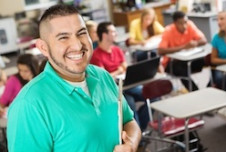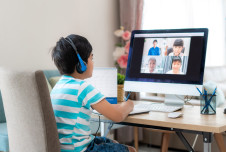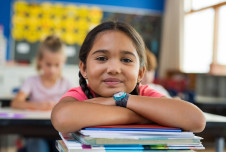Today, school leaders—superintendents, principals, and department heads—are faced with a challenge: uniting and inspiring their school communities in the midst of COVID-19.
This formidable task will not only be about implementing new safety guidelines. And it’s not just about the hard, strategic work of adjusting curriculums and programs to accommodate all the educational issues raised by school closures.
It will also involve the deep, human work of establishing a climate of care, one in which school leaders care for returning teachers, and returning teachers, in turn, care for the children and families they work with, creating ripples of support across the school community.
Three key mindsets—informed by research from education, leadership, and positive psychology—can help with this work of caring for school communities: a strength-based approach, collective leadership, and kindness.
1. Take a strength-based approach
A strength-based approach to teaching and learning focuses on what is working—what children and teachers can do. Leaders with this approach articulate for their community the ways in which they have been strong, and help to leverage those strengths to face the new work ahead of them.
Bonnie Bennard’s and Sara Troubridge’s research, as well as work by others, has connected a strength-based educational approach to the development of resilience in children and teachers. Now, more than ever, a strength-based approach is needed to build the resilience necessary for the many setbacks and disappointments inflicted by the pandemic.
How? School leaders can ask teachers to share how they have taken care of themselves during a challenging time, and how this experience has enhanced their abilities to cope, to persist, to learn digital skills, and to teach—the best they could. These discussions with teachers serve not just to honor the work they have done during challenging times, but also to help them recognize that the challenges they experienced have morphed into strengths and interests, ones they can apply to a new learning environment in a new school year shaped by the pandemic.
Similarly, with children, teachers can take a strength-based approach by encouraging them to share and draw on the strengths and interests they gained while at home during school closures and the summer months. The child who helped to assemble a table and chairs during quarantine, or the one who regularly watered the family houseplant, or the one who navigated a complex video game—each child learned something. Children are always developing and growing based on their experiences, even when their realities change.
Without failing to recognize the very real suffering and hardship experienced by many children during the pandemic, teachers can provide opportunities for children to share, extend, and reflect on how the learning they did at home made them stronger and more capable of succeeding at what’s next.
2. Cultivate collective leadership
Collective, or distributed, leadership assumes that input from teachers and families matters to the running of schools. Why this might be essential to creating a sense of belonging and connection is obvious. What may be less obvious is the way that collective leadership can potentially make a school more innovative and successful in its approach to problem solving, a vital skill as schools navigate the uncharted waters of reopening.
In a recent essay, Jonathan Supovitz at the University of Pennsylvania and his colleagues explain why distributed leadership can help schools face adaptive challenges. That is to say, challenges where there is no known solution to the problem, or challenges where there are too many solutions but no clear choices—the very kinds of problems that schools need to solve during the pandemic. As they write:
Particularly when addressing adaptive challenges, distributed leadership encourages the involvement of a diverse set of people with different expertise, perspectives, and backgrounds to grapple with the root causes of a problem. . . . And it is exactly because of the diversity of people’s experiences and perspectives that innovative solutions become more visible.
This diverse approach to adaptive challenges, enabled by distributed leadership, could be useful to school leaders and school communities during reopening.
For example, many school leaders and school communities are trying to address the issue of children reading at levels lower than those typically associated with their grade level as a result of disrupted instruction. A principal or reading specialist trying to address this challenge might see only a few solutions to the challenge—while a broader group that includes teachers and parents may brainstorm a wider range of innovative solutions that consider how children learned effectively at home during school closures, and what literacy practices they observed that really motivated and inspired children. These might include things like more time to read and write on topics of their own choice, and the integration of literacy learning with learning about the world around them.
Together, such a diverse group of faculty and families may even come to the recognition that reorganizing the school day to prioritize high-impact practices could address learning loss in dramatic ways. Having helped to find a range of innovative solutions together, a school community is then motivated to try them, adjust them, and persist with them until they work.
3. Enact kindness
In his recent book, The War for Kindness, Stanford psychology professor Jamil Zaki reminds us of how important benevolence is to organizations such as schools, not just in the lives of individuals:
Organizations that emphasize kindness flourish. . . . We are not merely individuals fighting to empathize in a world of cruelty. We are also communities, families, companies, teams, towns, and nations that can build kindness into our culture, turning it into people’s first option.
How can school leaders turn kindness into their first option as schooling continues through the pandemic?
The answer to this question will, of course, be unique to different school communities, but it is easy to imagine that most efforts to enact kindness will entail deep listening, thoughtful communication, and empathy. Empathy in this case takes the form of listening to—and really acknowledging—another’s pain and suffering, without attempting to “solve” it. This can be a hard stance for school leaders to adopt, as their jobs often cast them in the roles of “doers” and “solvers.”
In Dare to Lead, researcher and author Brené Brown recommends the following steps for enacting empathy, in the form of a list of what “I” could do to be empathic:
First: I take the perspective of another person, meaning I become the listener and the student, not the knower. Second: I stay out of judgment. And third and fourth: I try to understand what emotion they’re articulating and communicate my understanding of that emotion.
For school leaders, Brown’s “empathy steps” could help with staff and family discussions around stress and tribulations likely to arise throughout the year. Imagine if a teacher, who confides that he cannot concentrate on his class because he is still mourning the loss of a parent to COVID-19 while getting his own children comfortable with going to school again, were met by a principal who listened deeply to him and took the time to let a real conversation unfold without judgment. This teacher will more likely be motivated to meet his challenges with confidence because he felt appreciated and supported, rather than told how to quickly “fix” everything.
With the key mindsets we have looked at—a strength-based approach, collective leadership, and kindness—school leaders can establish a lasting climate of care in their school communities. Useful now, in the throes of a pandemic, these mindsets are likely to be equally valuable down the road, in a future where sustaining school communities, in person and virtually, will depend on the cultivation of care.









Comments